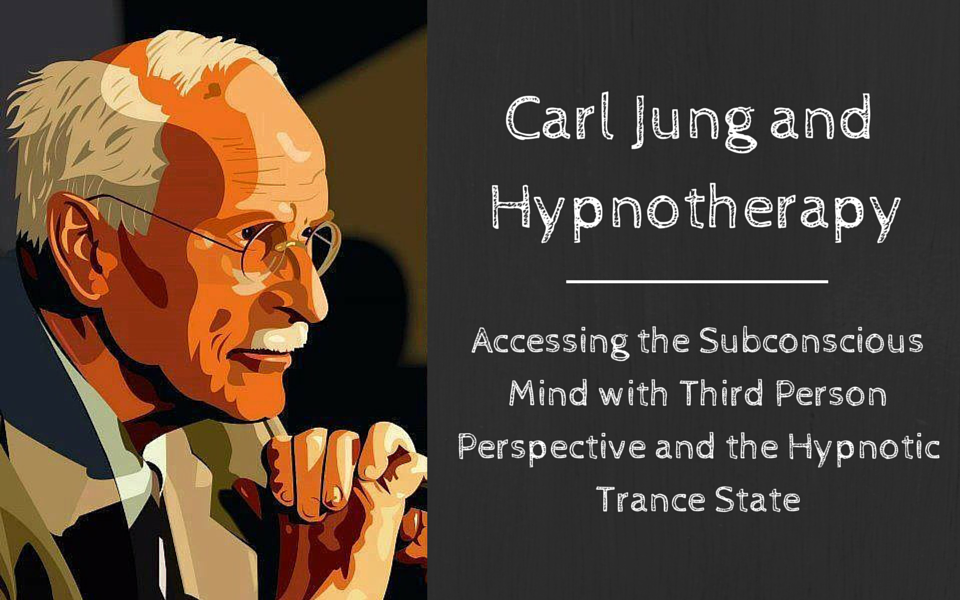Accessing the Subconscious Mind: Using Third Person Perspective and the Hypnotic Trance State [Jung]
Accessing the Subconscious Mind: Using Third Person Perspective and the Hypnotic Trance State [Jung]
About this series: Over the next few weeks, we will be discussing the work of Carl Jung on this blog and the role his work plays into hypnotherapy. Today's post is about the Third Person Perspective/Hypnotic trance state and how it helps clinical therapists gain easier access to the subonscious mind of their clients.

Freud and Jung both used hypnosis clinically, and each eventually decided to use an alternative approach to accessing the unconscious: Freud developed the technique of free association, and Jung began to use active imagination. Both of these techniques utilize a state of consciousness that might be labeled reverie, and could well be recognized as a form of self-hypnosis. Jay Haley once said, “Psychoanalysis is just hypnosis in slow motion.”
Simply, “hypnosis can be understood as direct activation of the implicit memory system”.[1] Implicit memory[2],[3] is a component of our somatic memory; it is a brain faculty present prenatally. This form of memory is devoid of a conscious experience of recollection, but includes behavioral, emotional, perceptual and somatosensory forms of memory.
Explicit memories are generally stored with awareness of the role of the self in the event (Kihlstrom, 1987), i.e. they are first person memories, whereas implicit memories are frequently of what to do rather than who did it, and are therefore seen as impersonal or third person. The activation of implicit memories can often seem devoid of reference to the self. One does not remember having learned to perform the procedure and it seems to be carried out automatically. The identification of the self with the memory has been viewed as an important criterion for the development of self identity (Kihlstrom, 1987). However, the availability of an implicit memory system suggests that we have a template within our brain for the paradox of experiencing ourselves in the third person.[4]
The hypnotic trance state offers just this third person perspective, and provides access to, and indeed activates, the somatic unconscious through implicit memories. In adulthood, triggers of implicit memory recollections can be experienced as non-verbal sensations or behavioral impulses. Such felt experience can be incorporated into active imagination, as shown by the work of Jungian analysts Joan Chodorow[5], Wendy Wyman-McGinty[6], and Shayne Spitzer[7],[8]. Embodied implicit memory formulates in any depth exploration of the psyche, be it analysis, dream work, or hypnotherapy. The body has a versatile, integrative language of its own as it gives physical form to psychological realities that may be otherwise silent. Paying attention to what is being said through this language first requires accessing it and becoming fluent in it. Hypnosis is well documented as a vehicle for accessing and focusing on the somatic unconscious. Further, such access benefits the hypnotherapy subject in solidifying new behavior patterns that result from the therapeutic intervention, rendering them automatic, with implicit rather than explicit control.
There is an indefinable state of consciousness that facilitates depth exploration of the psyche, variously referred to as “evenly hovering attention”, reverie, abaissement de niveau mental, perhaps a form of self-hypnosis that can apply to both the patient and the therapist. The hypnotic state provides just this portal of access to the personal and collective unconscious: active imagination type experiences, or perhaps amplification of “dreamlike” material. These are some of the possibilities that unfold:
- age regression. With hypnosis we can return to pivotal experiences in development where the deepest layers of psychic damage occurred and “re-experience” them in the ego state that laid down those critical state-dependent memories (revivify as distinct from “remembering” them). In this way, one finds a trackable trail of development of the complexes at work in one’s life today.
- clear recognition of projections of one’s own unacceptable traits onto the image of another, i.e., re-claiming those projections back into the self-image. One end of the spectrum of troublesome projection is using the defense to avoid personal accountability by blaming others; the other end of the spectrum is having no projections at all, which Jung considered an explanation of narcissism in which all psychic energy is hoarded by the subject.[9]
- externalizing dissociated psychic parts for more objective identification and dialogue, as we do in transference/ projection and in active imagination. The hypnotic trance state facilitates constructive contact with these “splinter personalities”, or complexes.
- interacting a la active imagination with elements from a dream.
- making contact with inner masculine or feminine through somatic awareness (recognizing the significance of symptoms or sensations on the right or left side of the body, or direct experience of the sympathetic/ parasympathetic syzygy).
- giving voice to age-regressed child parts, source of aspects of one’s psyche that we might label shadows or complexes, allowing a direct dialog between ego and complex.
- rehearsing with an imagined other (either someone actually in the client’s life who can be imaginally conjured during the session, or someone who is imagined as a potential interactant for practice purposes). An example is Milton Erickson’s Rehearsal Technique.[10]
Hypnotherapy and hypnotic psychodrama, through the technology of the hypnotic trance state, can also readily support shamanic techniques such as:
- soul retrieval, i.e., reclaiming split-off parts of the personality, or resources that were lost, stolen, murdered, appropriated, or jettisoned early in life.
- speaking directly with a deceased loved one.
- calling on archetypal resources (power animals, spirit guides, ancestors) for help with healing.
Conclusion
There's a lot to learn from Jung's unique incorporation of hypnotherapy. If you'd like to remain subscribed to this series and not miss an update, simply input your email in the top right (if you are viewing this on your computer) or the end of this post (if you are reading this on your mobile phone). By subscribing, you can insure you won't miss a single update on this series.
Of course, if you'd like to follow in his footsteps and incorporate hypnotherapy into your own practice, we have a training and certification course for that. Just click the banner below to download the course guide.
References
[1] Spiegel, D. (1998). Hypnosis and implicit memory: Automatic processing of explicit content. American Journal of Clinical Hypnosis, 40(3), 231-240.
[2] Schore, A. N. (2001). The effects of early relational trauma on right brain development, affect regulation, and infant mental health. Infant Mental Health Journal, 22(1–2), 201–269.
[3] Panksepp, J. (1998). Affective Neuroscience: The Foundations of Human and Animal Emotions. New York: Oxford University Press.
[4] Spiegel, D. (1998). Hypnosis and implicit memory: Automatic processing of explicit content. American Journal of Clinical Hypnosis, pg. 254.
[5] Chodorow, J. (2003). The Body as Symbol: Dance/Movement in Analysis. Retrieved from http://www.cgjungpage.org/index.php?option=com_content&task=view&id=88&Itemid=40.
[6] Wyman-McGinty, W. (2004). Growing a mind: The evolution of thought out of bodily experience. Proceedings of the 16th International IAAP Congress for Analytical Psychology, Barcelona, Spain.
[7] Spitzer, S. (2004). Kinaesthetic active imagination: A clinical picture. Proceedings of the 16th International IAAP Congress for Analytical Psychology, Barcelona, Spain.
[8]Spitzer, S. (2001). Embodied implicit memory. Cambridge 2001: Proceedings of the 15th International Congress for Analytical Psychology, 327-328. Einsiedeln, Switzerland: Daimon Verlag.
[9] Jung, C. G. (1966). The Collected Works of C. G. Jung, second edition. Princeton: Bollingen.
[10] Erickson, M. (1954). Special techniques of brief hypnotherapy. Journal of Clinical and Experimental Hypnosis, 2, 109-120.









